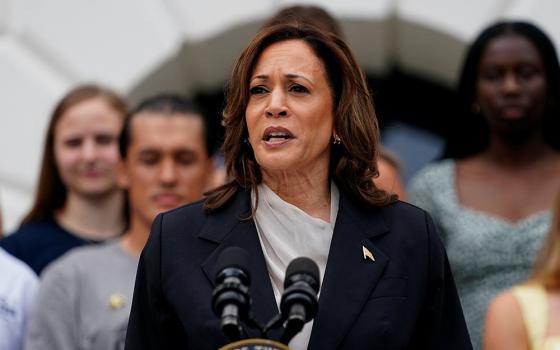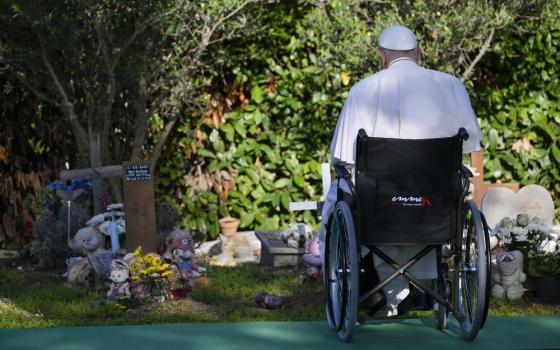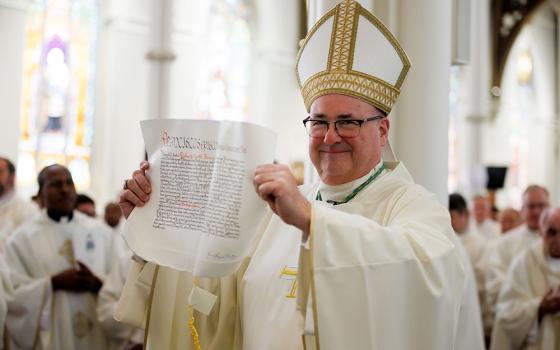Last week I mentioned that CUA’s Institute for Policy Research & Catholic Studies and the Public Religion Research Institute were teaming up for an event at the National Press Club about the role of religion in the 2012 elections. The event was yesterday, and in one of the happiest signs that the mainstream media finally “gets it,” the room was packed with reporters.
The event also marked the release of a new book by George Mason University Professor Mark Rozell, Religion and the American Presidency. Rozell kicked off the panel by noting that religion is “an under-appreciated and under-studied variable in presidential elections.” He noted that the biographies of presidents tend to ignore or downplay the influence of religious attitudes and beliefs on their decisions, which brought to me mind something Pope Benedict XVI said about those scholars who seek the “historical Jesus,” namely, that their portraits tend to end up like mirrors, reflecting their own concerns and prejudices rather than their subject.
Rozell also noted that many presidents in previous times were uncomfortable with the kind of “public displays of faith” that have become the norm. This has less to do with the role of religion in society and more to do with the intrusive nature of political reporting in recent decades, and it is not only in areas of faith. All but a handful of Americans knew about Lucy Mercer during FDR’s tenure in office. Indeed, most Americans did not realize just how badly crippled FDR was. And no one ever asked FDR, as someone once publicly asked Bill Clinton, “Boxers or briefs?” But, it also has something to do with the face of religion. The rise of televangelists gave us an up close and personal look at religious leaders in a way we had not before and broadcast religious services, making them less private and more public. And, in this “confessional” culture of ours, it has served the interest of a variety of celebrities, when they get into trouble, to talk about their redemption.
Robert P. Jones, CEO of PRRI, talked about the “shifting religious landscape,” and presented some data that really was startling. He noted that, for the first time in our nation’s history, there are no Protestants on the Supreme Court and that this change reflects a demographic change in American society. In 1974, Protestants constituted 63% of the population. Today, that number is 50%. Think of that for a minute. Protestants are about to become a minority. And, if you put the “W” back into “WASP” the numbers are even starker because the percentage of black Protestants in the U.S. has remained steady. In 1974, white Protestants were 54% of the population but in 2010 that number was down to 36%. And, because membership in evangelical churches has remained steady, that decline has been almost completely among the ranks of mainline churches.
Catholics have stayed steady as a percentage of the population, but only because of the influx of Latino Catholics. In 1991, the ratio of white, non-Hispanic Catholics to Latino Catholics was 10-1. Today, Latinos constitute a third of all Catholics.
Jones also recalled the religious breakdown in the 2008 election. White evangelicals strongly supported McCain, but most groups strongly supported Obama including Latino Catholics, black Protestants, those with no religious affiliation, and “other,” including Jess, Hindus, Muslims, etc. The most closely divided cohorts were white Catholics and white mainline Protestants. Both groups broke narrowly for McCain. Looking at 2012, white mainline Protestants and white Catholics will likely be the most closely divided groups again.
Looking ahead to tonight’s primary results in Florida, Jones explained how the religious landscape there is more favorable to Romney and less so to Gingrich. In South Carolina, where Gingrich thumped Romney, 65 percent of the GOP primary electorate were white evangelicals and Gingrich carried them handily. In Florida, only 39% of the primary electorate will be white evangelicals. Those numbers correspond closely to those who identify themselves as “very conservative.” In Florida, 27% label themselves very conservative compared to 36% in the Palmetto State. And, for the first time in a GOP primary this season, we will see tonight a large percentage of non-white GOP voters. In South Carolina, only one percent of the GOP primary electorate was Latino but that number rises to 16 percent tonight in Florida.
Professor Melissa Deckman of Washington College discussed the 1928 Al Smith candidacy and the 1960 JFK campaign to assess the role of anti-Catholic bigotry and what that might or might not mean for Mitt Romney who is seeking to become the first Mormon president. She noted that Romney in 2008, like Kennedy in 1960, addressed the issue head-on in a speech that was widely praised. But, she noted that more Americans likely knew something of the Catholic Church, or knew a Catholic, in 1960 than know anything about Mormonism, or personally know a Mormon today. Mormons are only 2 percent of the national population after all.
Deckman also noted that Kennedy’s religion may have cost him some votes, but it also helped gin up turnout on his behalf among Catholic voters. There will not likely be any “Mormon bounce” given their smaller numbers.
Batting clean-up was Professor Steve Schneck, director of the IPRCS at CUA. He said the narrative that religion is in decline in America is something of a myth, that religious adherence has always waxed and waned over the decades of American life, but that the general trajectory since the time of the founding has been upward. Schneck also mentioned something that I think escaped the White House decision makers on the HHS conscience clause: “religions rise and thrive when they have a complicated relationship with society,” Schneck argued, not when everything is wine and roses.
Schneck also noted a theme close to my heart: Religion is often seen as a “conservative” force in society, but in fact, there is a “swinging pendulum” of ideological identification amidst the variety of religious influences over time. Before Jerry Falwell, the most prominent clergyman in America was likely Father Robert Drinan, S.J., the Jesuit member of Congress and leading anti-war advocate. Before Drinan, Dr. King was the leading religious figure. The list goes on.
Finally Schneck argued that the “Catholic vote” is not a myth, but it is also not a monolith. Catholics certainly share the attitudes of other non-Catholics if you look at them in terms of their race, wealth, gender, etc. But, Schneck profoundly noted that today’s Catholics are less likely to be “cradle Catholics” and more likely to be intentionally Catholic. In the first half of the twentieth century, you were Catholic because you were born to a given family in a given neighborhood. Today, many of those who don’t care much about their faith have left. This “disaffiliation” of white Catholics has resulted in a “distillation” of those Catholics who remain. This is a very, very smart insight. Schneck also speculated that the increased political prominence of the bishops could be reaching a tipping point. I wish he had had the time to elaborate on this point. I am not sure which way it will tip!
There are some downsides to living in DC – the Beltway traffic, the inconsistent weather which has my spring bulbs peeping up already after this warm January, etc. But, being able to attend an event like yesterday’s is one of the highlights. Kudos to Barbara Bradley Haggerty who moderated the event and to all the panelists. Finally, the role of religion in American politics is getting the attention it deserves.




